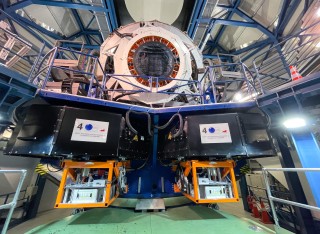
Harry Addison
About
My research project
SNe spectroscopy and cosmologyThe Time-Domain Extragalactic Survey (TiDES) will conduct spectroscopic follow up of optical transients observed by upcoming sky surveys such as the Large Synoptic Survey Telescope (LSST). Over TiDES proposed observing timeline, it will observe spectra of over 30,000 supernovae (SN), of which about 25,000 will be type Ia SN. This will be the largest spectroscopic sample of SNe Ia to date and will allow us to further investigate the properties of sub-types of SN Ia and their systematic effects in the use for constraining the cosmological model and dark energy. Due to the large number of spectra that will be observed, we are at a stage where visually analysing data is impractical. Therefore, we are currently developing a pipeline for TiDES that will automate the spectroscopic analysis of the observed supernovae spectra. In the future, we hope to the use the results from the spectral analysis to investigate the systematics present in using SNe Ia for constraining the cosmological model and dark matter.
As a member of 4MOST, I have been given the opportunity to be involved with the commissioning of the spectrograph on ESO's VISTA telescope (Paranal, Chile). The commissioning of 4MOST will involve understanding the procedures used to validate the spectrograph and telescope are working as intended, carrying out these procedures on site at Paranal, and monitoring/rectifying/minimising the effects of any issues that arise.
Supervisors
The Time-Domain Extragalactic Survey (TiDES) will conduct spectroscopic follow up of optical transients observed by upcoming sky surveys such as the Large Synoptic Survey Telescope (LSST). Over TiDES proposed observing timeline, it will observe spectra of over 30,000 supernovae (SN), of which about 25,000 will be type Ia SN. This will be the largest spectroscopic sample of SNe Ia to date and will allow us to further investigate the properties of sub-types of SN Ia and their systematic effects in the use for constraining the cosmological model and dark energy. Due to the large number of spectra that will be observed, we are at a stage where visually analysing data is impractical. Therefore, we are currently developing a pipeline for TiDES that will automate the spectroscopic analysis of the observed supernovae spectra. In the future, we hope to the use the results from the spectral analysis to investigate the systematics present in using SNe Ia for constraining the cosmological model and dark matter.
As a member of 4MOST, I have been given the opportunity to be involved with the commissioning of the spectrograph on ESO's VISTA telescope (Paranal, Chile). The commissioning of 4MOST will involve understanding the procedures used to validate the spectrograph and telescope are working as intended, carrying out these procedures on site at Paranal, and monitoring/rectifying/minimising the effects of any issues that arise.
Affiliations and memberships
Publications
The Time Domain Extragalactic Survey (TiDES) conducted on the 4 m Multi-Object Spectroscopic Telescope will perform spectroscopic follow-up of extragalactic transients discovered in the era of the NSF-DOE Vera C. Rubin Observatory. TiDES will conduct a 5 yr survey, covering $\gt 14,000\,\mathrm{square}\,\mathrm{degrees}$ , and use around 250,000 fibre hours to address three main science goals: (i) spectroscopic observations of >30,000 live transients, (ii) comprehensive follow-up of >200,000 host galaxies to obtain redshift measurements, and (iii) repeat spectroscopic observations of active galactic nuclei to enable reverberation mapping studies. The live spectra from TiDES will be used to reveal the diversity and astrophysics of both normal and exotic supernovae across the luminosity-timescale plane. The extensive host-galaxy redshift campaign will allow exploitation of the larger sample of supernovae and improve photometric classification, providing the largest-ever sample of SNe Ia, capable of a sub-2% measurement of the equation-of-state of dark energy. Finally, the TiDES reverberation mapping experiment of 700–1000 AGN will complement the SN Ia sample and extend the Hubble diagram to z ∼ 2.5.
The Time Domain Extragalactic Survey (TiDES) conducted on the 4-metre Multi-Object Spectroscopic Telescope (4MOST) will perform spectroscopic follow-up of extragalactic transients discovered in the era of the NSF-DOE Vera C. Rubin Observatory. TiDES will conduct a 5-year survey, covering ${>}14\,000\,\mathrm{square\, degrees}$, and use around 250 000 fibre hours to address three main science goals: (i) spectroscopic observations of ${>}30 000$ live transients, (ii) comprehensive follow-up of ${>}200 000$ host galaxies to obtain redshift measurements, and (iii) repeat spectroscopic observations of Active Galactic Nuclei to enable reverberation mapping studies. The live spectra from TiDES will be used to reveal the diversity and astrophysics of both normal and exotic supernovae across the luminosity-timescale plane. The extensive host-galaxy redshift campaign will allow exploitation of the larger sample of supernovae and improve photometric classification, providing the largest-ever sample of spec-confirmed type Ia supernovae, capable of a sub-2 per cent measurement of the equation-of-state of dark energy. Finally, the TiDES reverberation mapping experiment of 700--1\,000 AGN will complement the SN Ia sample and extend the Hubble diagram to $z\sim2.5$
Early-time spectroscopy of supernovae (SNe), acquired within days of explosion, yields crucial insights into their outermost ejecta layers, facilitating the study of their environments, progenitor systems, and explosion mechanisms. Recent efforts in early discovery and follow-up of SNe have shown the potential insights that can be gained from early-time spectra. The Time-Domain Extragalactic Survey (TiDES), conducted with the 4-meter Multi-Object Spectroscopic Telescope (4MOST), will provide spectroscopic follow-up of transients discovered by the Legacy Survey of Space and Time (LSST). Current simulations indicate that early-time spectroscopic studies conducted with TiDES data will be limited by the current SN selection criteria. To enhance TiDES's capability for early-time SN spectroscopic studies, we propose an additional set of selection criteria focusing on early-time (young) SNe (YSNe). Utilising the Zwicky Transient Facility live transient alerts, we developed criteria to select YSNe while minimising the sample's contamination rate to 28 percent. The developed criteria were applied to LSST simulations, yielding a sample of 1167 Deep Drilling Field survey SNe and 67388 Wide Fast Deep survey SNe for follow-up with 4MOST. We demonstrate that our criteria enables the selection of SNe at early-times, enhancing TiDES's future early-time spectroscopic SN studies. Finally, we investigated 4MOST-like observing strategies to increase the sample of spectroscopically observed YSNe. We propose that a 4MOST-like observing strategy that follows LSST with a delay of 3 days is optimal for the TiDES SN survey, while a 1 day delay is most optimal for enhancing the early-time science in conjunction with our YSN selection criteria.
Luminous red novae (LRNe) are astrophysical transients believed to be caused by the partial ejection of a binary star's common envelope (CE) and the merger of its components. The formation of the CE is likely to occur during unstable mass transfer, initiated by a primary star which is evolving off the main sequence (a Hertzsprung gap star) and a lower mass companion. In agreement with observations, theoretical studies have shown that outflows from the pre-CE phase produce a detectable brightening of the progenitor system a few years before the ejection event. Based on these assumptions, we present a method to identify Galactic LRNe precursors, the resulting precursor candidates, and our follow-up analysis to uncover their nature. We begin by constructing a sample of progenitor systems, i.e. Hertzsprung gap stars, by statistically modelling the density of a colour magnitude diagram formed from 'well behaved' Gaia DR2 sources. Their time-domain evolution from the Zwicky Transient Facility (ZTF) survey is used to search for slowly brightening events, as pre-CE precursor candidates. The nature of the resulting candidates is further investigated using archival data and our own spectroscopic follow-up. Overall, we constructed a sample of similar to 5.4 x 10(4) progenitor sources, from which 21 were identified as candidate LRNe precursors. Further analysis revealed 16 of our candidates to be H alpha emitters, with their spectra often suggesting hotter (albeit moderately extincted) A-type or B-type stars. Because of their long-term variability in optical and mid-infrared wavelengths, we propose that many of our candidates are mass-transferring binaries with compact companions surrounded by dusty circumstellar discs or alternatively magnetically active stellar merger remnants.
